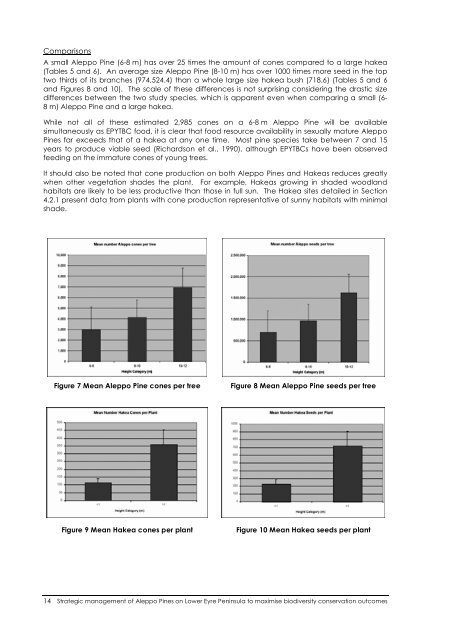Strategic management of Aleppo Pines on Lower Eyre
Strategic management of Aleppo Pines on Lower Eyre
Strategic management of Aleppo Pines on Lower Eyre
You also want an ePaper? Increase the reach of your titles
YUMPU automatically turns print PDFs into web optimized ePapers that Google loves.
Comparis<strong>on</strong>s<br />
A small <str<strong>on</strong>g>Aleppo</str<strong>on</strong>g> Pine (6-8 m) has over 25 times the amount <str<strong>on</strong>g>of</str<strong>on</strong>g> c<strong>on</strong>es compared to a large hakea<br />
(Tables 5 and 6). An average size <str<strong>on</strong>g>Aleppo</str<strong>on</strong>g> Pine (8-10 m) has over 1000 times more seed in the top<br />
two thirds <str<strong>on</strong>g>of</str<strong>on</strong>g> its branches (974,524.4) than a whole large size hakea bush (718.6) (Tables 5 and 6<br />
and Figures 8 and 10). The scale <str<strong>on</strong>g>of</str<strong>on</strong>g> these differences is not surprising c<strong>on</strong>sidering the drastic size<br />
differences between the two study species, which is apparent even when comparing a small (6-<br />
8 m) <str<strong>on</strong>g>Aleppo</str<strong>on</strong>g> Pine and a large hakea.<br />
While not all <str<strong>on</strong>g>of</str<strong>on</strong>g> these estimated 2,985 c<strong>on</strong>es <strong>on</strong> a 6-8 m <str<strong>on</strong>g>Aleppo</str<strong>on</strong>g> Pine will be available<br />
simultaneously as EPYTBC food, it is clear that food resource availability in sexually mature <str<strong>on</strong>g>Aleppo</str<strong>on</strong>g><br />
<str<strong>on</strong>g>Pines</str<strong>on</strong>g> far exceeds that <str<strong>on</strong>g>of</str<strong>on</strong>g> a hakea at any <strong>on</strong>e time. Most pine species take between 7 and 15<br />
years to produce viable seed (Richards<strong>on</strong> et al., 1990), although EPYTBCs have been observed<br />
feeding <strong>on</strong> the immature c<strong>on</strong>es <str<strong>on</strong>g>of</str<strong>on</strong>g> young trees.<br />
It should also be noted that c<strong>on</strong>e producti<strong>on</strong> <strong>on</strong> both <str<strong>on</strong>g>Aleppo</str<strong>on</strong>g> <str<strong>on</strong>g>Pines</str<strong>on</strong>g> and Hakeas reduces greatly<br />
when other vegetati<strong>on</strong> shades the plant. For example, Hakeas growing in shaded woodland<br />
habitats are likely to be less productive than those in full sun. The Hakea sites detailed in Secti<strong>on</strong><br />
4.2.1 present data from plants with c<strong>on</strong>e producti<strong>on</strong> representative <str<strong>on</strong>g>of</str<strong>on</strong>g> sunny habitats with minimal<br />
shade.<br />
Figure 7 Mean <str<strong>on</strong>g>Aleppo</str<strong>on</strong>g> Pine c<strong>on</strong>es per tree Figure 8 Mean <str<strong>on</strong>g>Aleppo</str<strong>on</strong>g> Pine seeds per tree<br />
Figure 9 Mean Hakea c<strong>on</strong>es per plant Figure 10 Mean Hakea seeds per plant<br />
14 <str<strong>on</strong>g>Strategic</str<strong>on</strong>g> <str<strong>on</strong>g>management</str<strong>on</strong>g> <str<strong>on</strong>g>of</str<strong>on</strong>g> <str<strong>on</strong>g>Aleppo</str<strong>on</strong>g> <str<strong>on</strong>g>Pines</str<strong>on</strong>g> <strong>on</strong> <strong>Lower</strong> <strong>Eyre</strong> Peninsula to maximise biodiversity c<strong>on</strong>servati<strong>on</strong> outcomes

















